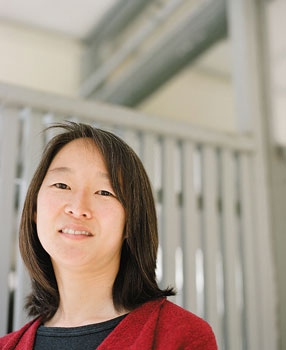
Special Report
In the thick of it
Stanford’s bioethicists serve as resources for researchers
By Susan Ipaktchian
Photo by Leslie Williamson
Mildred Cho, PhD
When Lauren Milner arrived at Stanford this past September to begin her postdoctoral fellowship in biomedical ethics, she knew she’d be sitting in on discussions involving the ethical implications of research projects. She was pleasantly surprised to find out that she’d also have the opportunity to participate in ethics discussions in Stanford’s hospitals, listening as doctors and other health-care providers wrestled with decisions involving their patients.
“Watching these doctors and other people try to hash out the best decision is really heartening, and that’s what this is all about — individual people with individual problems that need guidance,” says Milner, PhD, whose background is in behavioral genetics.
The interplay of clinical and research ethics makes Stanford’s Center for Biomedical Ethics and its fellowship program unusual. While many medical schools have bioethics centers that address academic or research-oriented questions, they often focus solely on conducting their own research. But the members of Stanford’s center play leadership roles in the hospitals’ ethics committees, acting as resources for physicians as well as patients and their families in making difficult decisions under stressful circumstances. In addition, the center in 2004 initiated a “benchside” consult service for researchers that is now operated through Spectrum, the medical school’s center for clinical and translational research.
Stanford’s training program is funded by a federal grant received in 2004 to create the Center for the Integration of Research on Genetics and Ethics. CIRGE is one of six centers funded by the National Human Genome Research Institute to explore the ethical, legal and social implications of genetic research.
Mildred Cho, PhD, the principal investigator for the CIRGE grant and associate director of the bioethics center, says the students in the postdoctoral program come from a variety of backgrounds — primarily from a bioscience field but also from law and social science. The postdocs spend the two to three years of their fellowship filling in the gaps in their backgrounds to become bioethicists. For those with science backgrounds, that means mastering the methodology of social science research (such as conducting interviews, coding the responses and looking for trends) as well as learning basic ethical theory and spending time getting exposure to clinical ethics.
“It’s very overwhelming during the first few months of the fellowship,” says Cho, who earned her PhD in pharmacology before moving into the bioethics field. “This is very different for trainees, especially if they’ve come from a laboratory science. They’re used to cutting up mice, whereas the social science methods that we use tend to be more observational.”
The strength of Stanford’s postdoctoral program is reflected in the success of its first three graduates, all of whom earned tenure-track faculty positions upon completing the program. “It’s hard enough to get a faculty position, and in bioethics there aren’t that many slots,” Cho says. “It speaks not just to the quality of the people selected for our program but also to the demand for bioethicists who have science training.”
Jen McCormick, PhD, who graduated from the program in 2008 and is now an assistant professor of biomedical ethics at the Mayo Clinic and College of Medicine, remembers feeling that she had stumbled upon a whole new world when she began her postdoctoral training. McCormick, who describes herself as a policy nerd, had already spent a year teaching science policy, doing research and writing a book after earning her doctorate in biology. Still, making the transition to bioethics “uncovered a huge gap in my knowledge. But it was one of the best things that ever happened to me,” she says.
As someone still making that transition from lab science to social science, Milner can attest to the magnitude of difference between the bench and bioethics. She laughs as she recalls a recent conversation with a colleague who asked if she thought qualitative or quantitative data would be better for a research project. “And I said, ‘What’s qualitative data?’
“I originally thought that bioethics would be just like science, only on social issues — but it’s really not,” she says. “I’m starting to understand that the way I learned to do research in a lab is not going to be productive in the field of ethics. These are issues that you can’t put in a beaker and run on a gel.”


